Review: The star at this new DTLA tamale spot? A machine
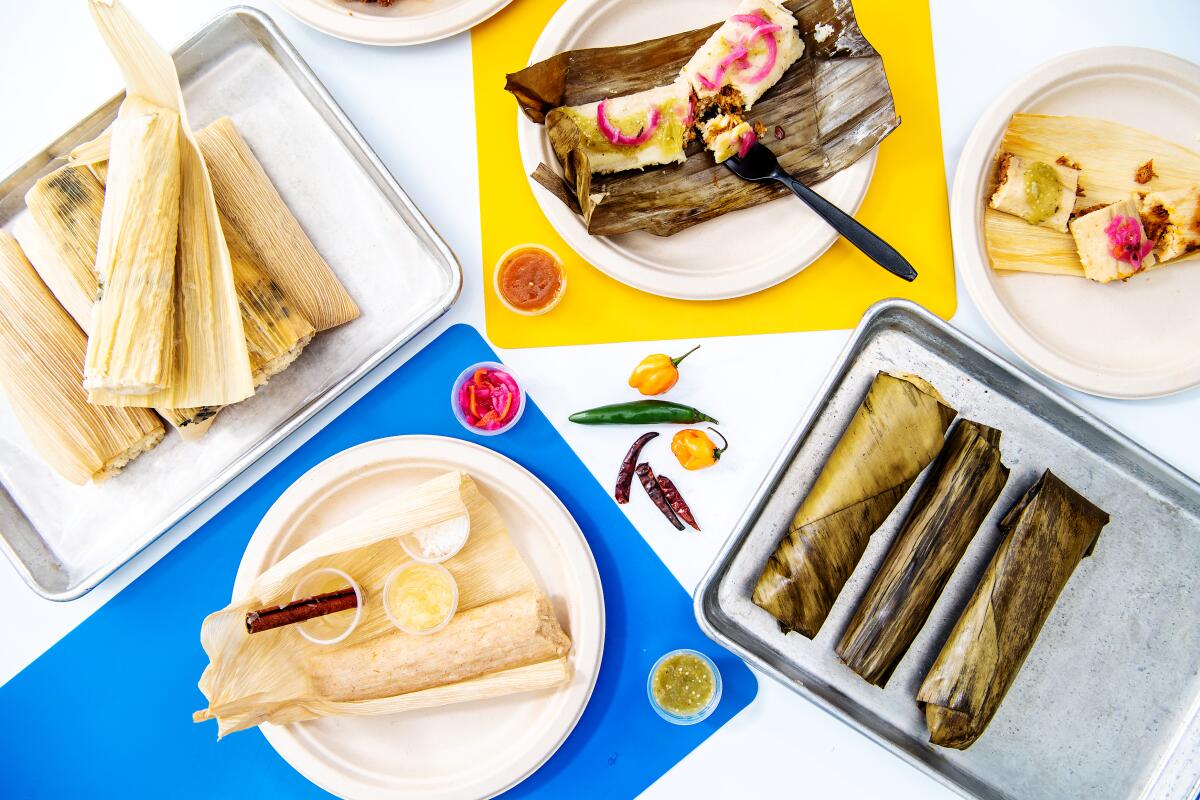
Is there an abuelita laboring over a basin of masa in the kitchen of Artesano Tamaleria?
There is not.
For the record:
3:09 p.m. Dec. 20, 2019A previous version of this story gave the incorrect price for tamales. The correct price is $3.25, not $3.35.
The backbone of the kitchen at this 4-month-old downtown tamale cafe is a hand-operated tamale-making machine called Tio Carlos’ Tamale King.
The patented machine, designed more than three decades ago by Texas restaurateur Charles T. Beavers (a.k.a. “Tio Carlos”), is equipped with two inconspicuous looking plastic cylinders: one for the extrusion of the masa, and the second for squeezing out the tamale fillings.
Recently I spent part of an afternoon absorbed by the ‘90s-era instructional video that demonstrates how to use the Tio Carlos’ Tamale King machine. I watched as tamales dribbled out of the nozzle wholly intact, fat as morning dewdrops.
The machine can press out hundreds of Mexican-style tamales an hour — smooth, chubby, unwrapped tubes of masa filled with meats, veggies, cheeses or whatever other sweet or savory ingredients a tamale chef can dream up.
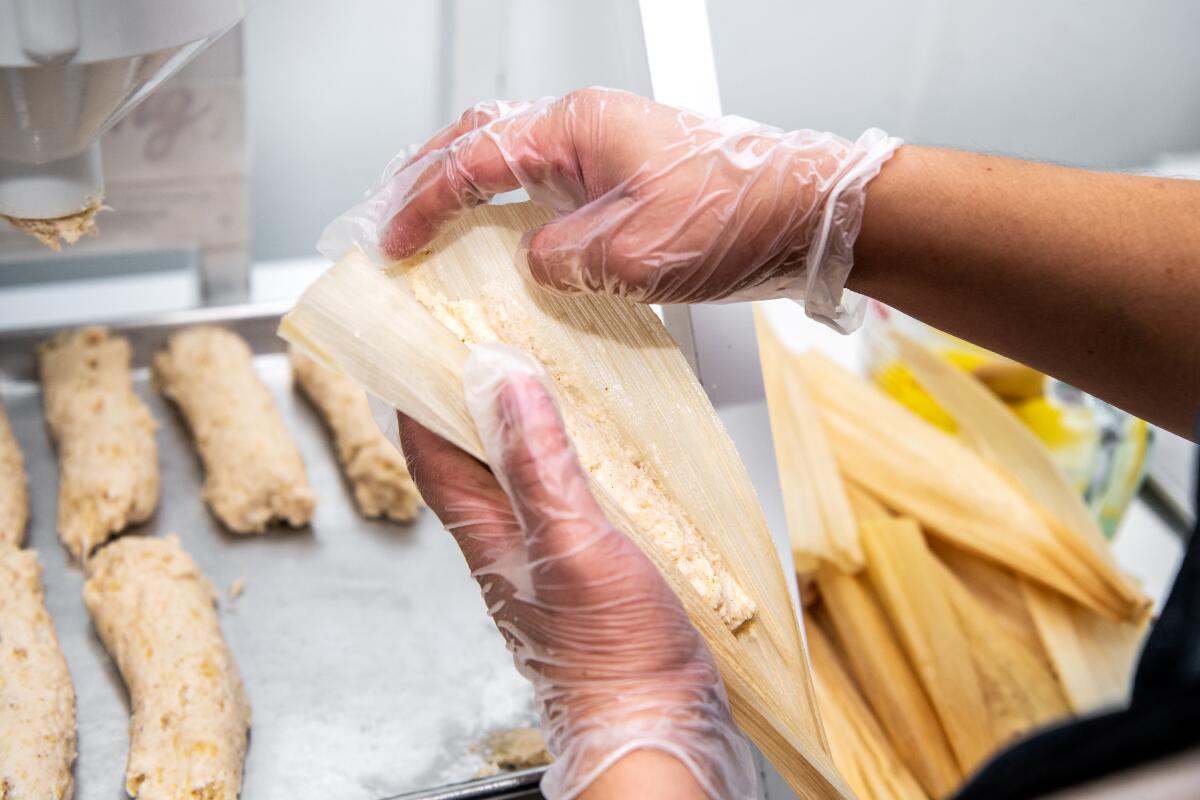
Afterward, they are hand-wrapped in either corn husks or banana leaves, then cooked as usual in the large steaming pots called vaporeras.
For traditionalists, this mode of tamale-making may seem antithetical to the idea of tamales as a naturally slow food centered around community. The ritual of tamaladas, women-centric tamale-making gatherings, stretches back to pre-Columbian times, and it continues to be an important part of family life across Latin America.
But tamale technology is not new; many professional tamale shops use machinery and kitchen tools like masa spreaders to save time and ramp up production, especially around the busy holiday season when tamales are in high demand in Mexico and the U.S. Southwest.
At Artesano Tamaleria, owners Jorge Gonzalez and Nelida Ayala say they aren’t interested so much in volume as optimizing for consistency.
Gonzalez and Ayala, both natives of Mexico, met while working for a multinational telecommunications firm in Los Angeles. Gonzalez’s background is in sales; Ayala is an engineer who trained at the Monterrey Institute of Technology, one of Latin America’s top universities.
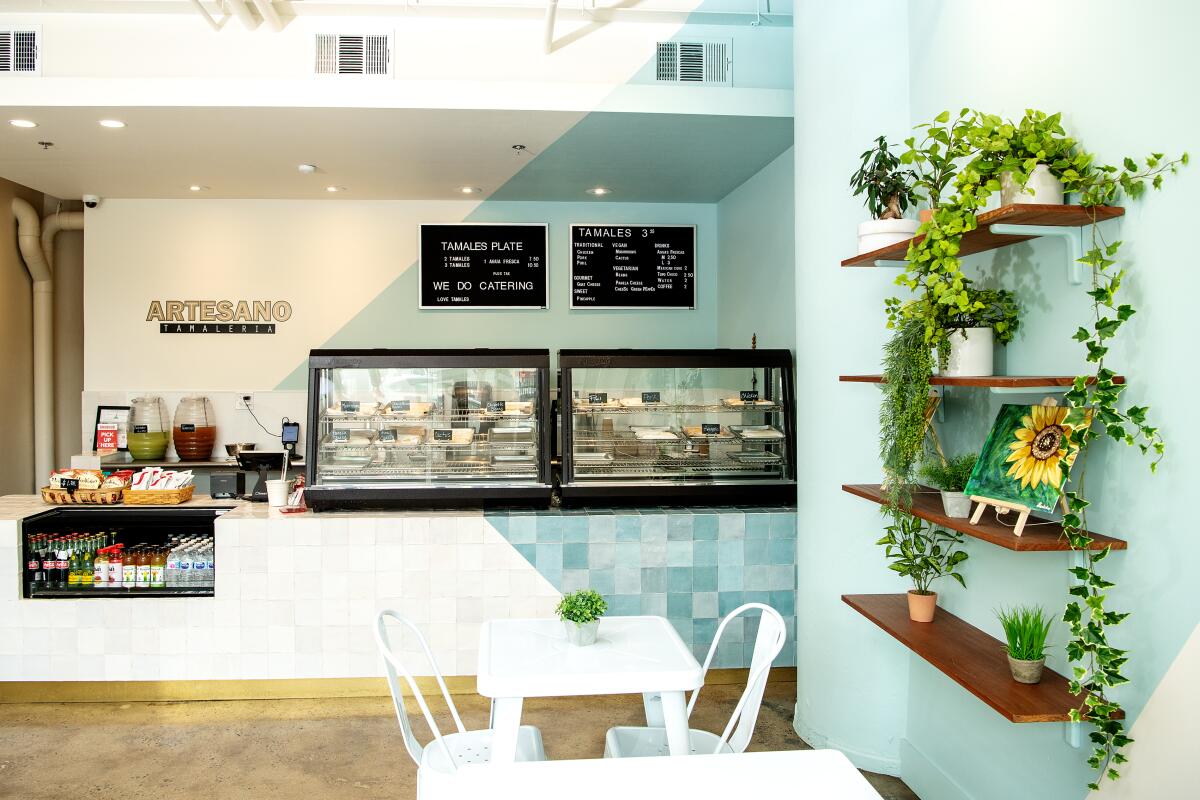
The pair left comfortable corporate jobs to launch Artesano Tamaleria — the restaurant’s tagline is “tamales reinvented” — in the Fashion District in August.
Gonzalez and Ayala aren’t so much reinventing tamales — it turns out that machine-made tamales do not taste radically different than those assembled by hand — as they are reimagining the neighborhood tamaleria (tamale shop).
The fast-casual restaurant, a sunlit storefront decorated minimally with arty, black-and-white photographs of corn husks, approximates the anodyne shine of a neighborhood Starbucks. Glossy white tables adorned with shiny plastic shrubbery entice customers to linger.
Unlike many neighborhood carryout shops, where much of the tamale inventory is stored somewhere in the back, Gonzalez and Ayala aim to showcase their product as much as possible.
Freshly steamed tamales, double-wrapped in slips of white parchment paper, are displayed in a glass display case like French pastries. They idle in neat rows, sweaty in their papery skins. Several batches are steamed throughout the day to replenish the case with fresh tamales every two or so hours.
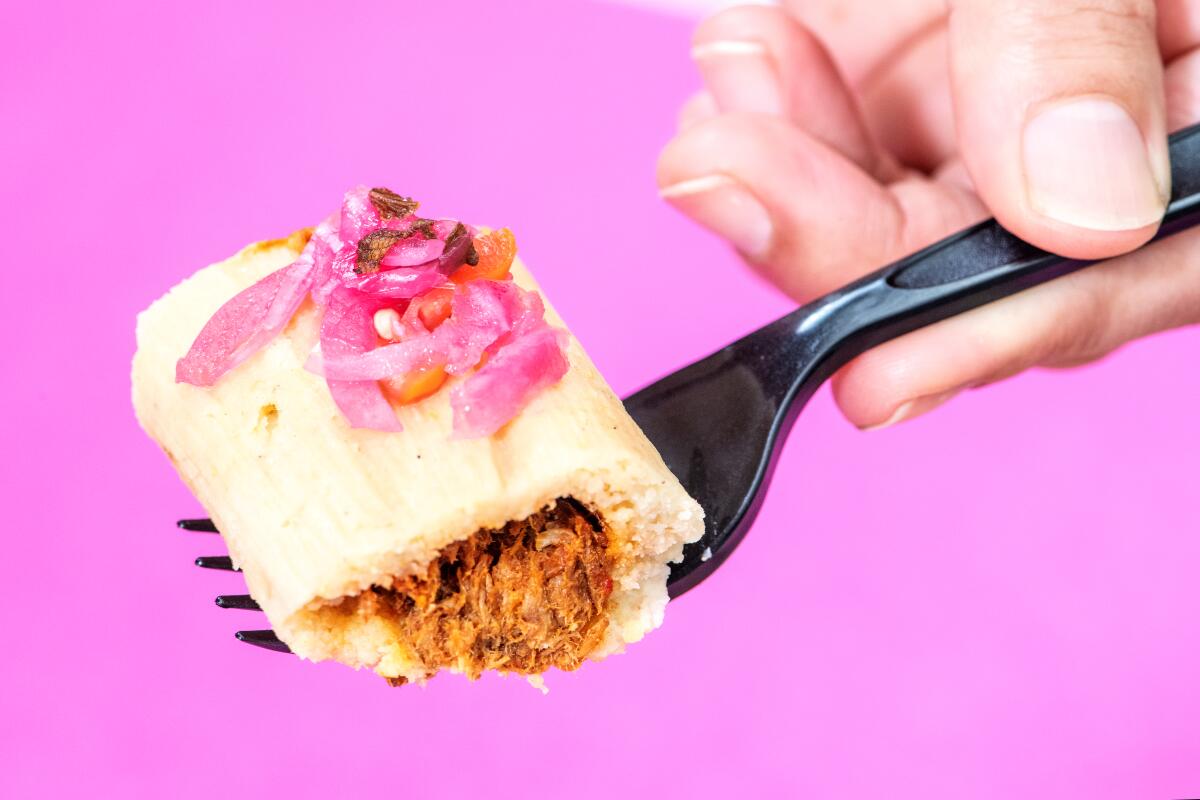
Gonzalez and Ayala, who don’t have previous kitchen experience, hired professional recipe developers to create a menu of 10 original tamale recipes, including familiar options (pork with red chile) and more unconventional tamales (goat cheese with tomatoes).
For masa, the kitchen uses a commercial dry corn flour blended with salt, vegetable shortening and baking soda, a combination that produces emphatically light, fluffy tamales. If you are categorically opposed to any variant of stodginess, Artesano’s pillowy, bantamweight tamales are probably your version of tamale heaven.
Traditional varieties shine: Chicken tamales are effusively tangy, filled with shredded chicken braised in a bright Serrano chile and tomatillo salsa. Red chile pork tamales are not the massive, extra-meaty logs you tend to find around potlucks this time of year, but rather supple, shapely cakes filled with shredded pork and a lightly stinging guajillo chile sauce.
If you were weaned on rajas tamales overflowing with molten white cheese and strips of roasted green chile, you will probably be disappointed by the cafe’s cheese tamale repertoire. Here, your best option is queso panela, a tamal padded with a thick, springy wedge of the semi-soft Mexican cheese: pleasant enough but forgettable. The queso cabra — goat cheese with roasted roma tomatoes — was dangerously crumbly on a recent visit.
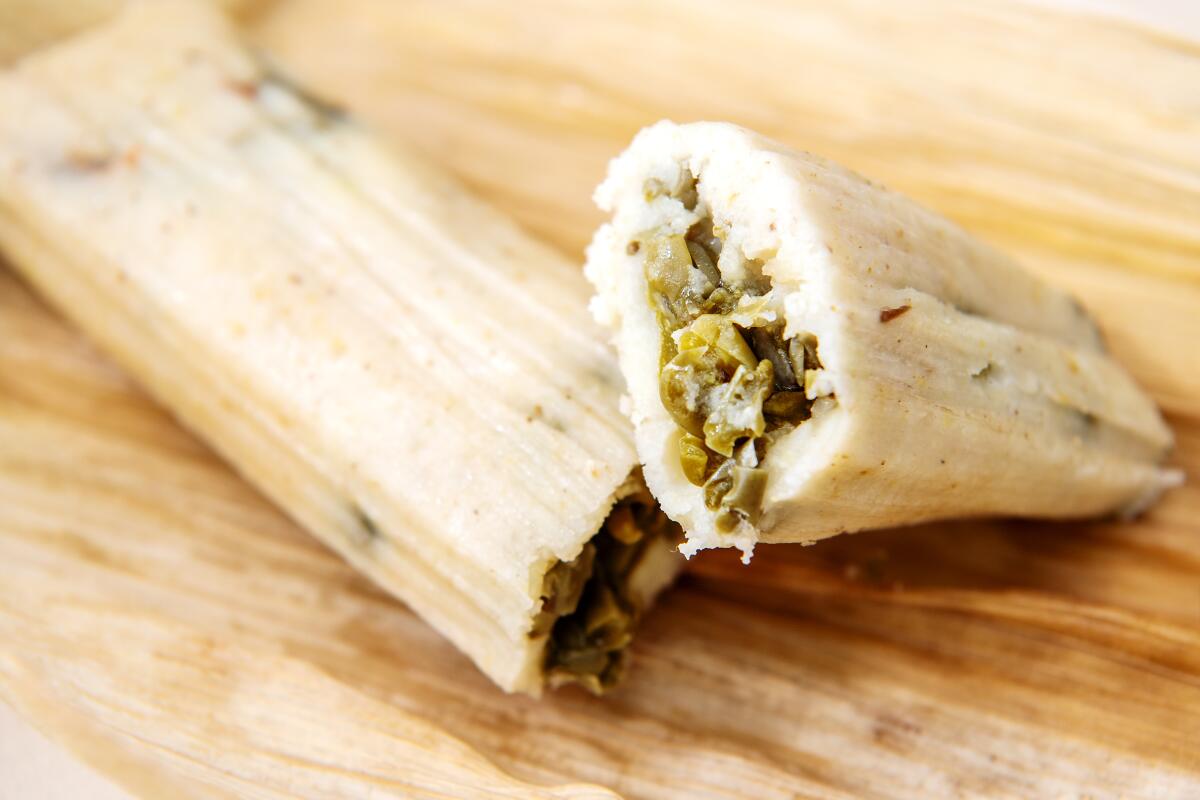
It’s worth the trouble of hunting for downtown parking for half a dozen of Artesano’s remarkably savory hongos (mushrooms) tamales. The masa — stippled with dark, meaty fragments of sauteed mushrooms and onions — is soft and moist, halfway between a cake and custard.
Velvety frijoles tamales are similarly compelling. The bean-heavy masa, marbled with chipotle-spiced refried beans, has a rich, meaty depth; Gonzalez has nicknamed the tamal “the Mexican Power Bar.”
There’s an excellent nopales tamal embedded with tangy shavings of prickly pear cactus and flecks of tomato and onions. The flavors cut brilliantly through the dish’s natural starchiness. You will also want to try a couple of the banana leaf-wrapped cochinita pibil tamales, whose achiote-spiced pork stains the masa a deep rust-red and almost splits open the tamale with its sweet-smoky juices.
Does it matter that the masa was not smeared onto the husks by hand? Is something still artisanal if it wasn’t extremely time-consuming?
In the vast tamale universe, where there as many ways to make the dish as there are tamales themselves, the final verdict is made at the table.
On that note, you will want to try the dessert option at Artesano Tamaleria, a pineapple and cinnamon tamal threaded with shredded coconut. Its flavors are as comforting as anything homemade: musty and warm, with a corn sweetness that tastes like summer, even in the dead of winter.

Artesano Tamaleria
Location: 819 Santee St., Los Angeles, (213) 947-3140, artesanotamaleria
Details: Credit cards accepted. No bar. Lot and street parking. Wheelchair accessible.
Prices: Tamales $3.25 each
Recommended dishes: Tamales: mushroom, nopales, cochinita pibil, pork, chicken, pineapple
More to Read
Eat your way across L.A.
Get our weekly Tasting Notes newsletter for reviews, news and more.
You may occasionally receive promotional content from the Los Angeles Times.










